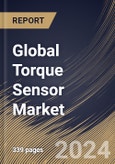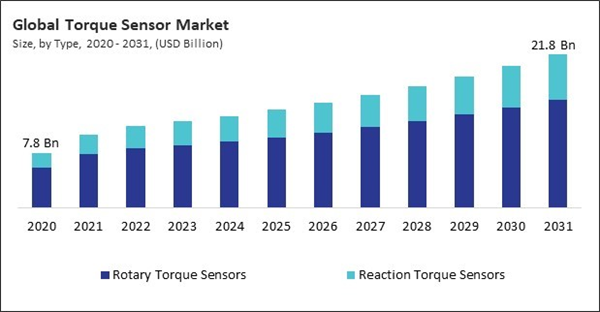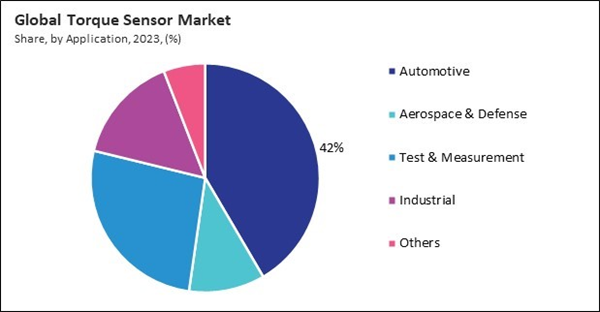The Global Torque Sensor Market size is expected to reach $21.8 billion by 2031, rising at a market growth of 7.6% CAGR during the forecast period. In the year 2023, the market attained a volume of 10,353.0 thousand units experiencing a growth of 18.1% (2020-2023).
North American region’s strong emphasis on R&D has led to developing advanced torque sensing technologies and solutions, driving adoption and demand. Consequently, the North America region would acquire nearly 24.6% of the total market share by 2031. Also, the USA market would utilize 3,345.0 thousand units of these sensors by 2031. North America, particularly the United States, is a hub for technological innovation and research in various industries, including automotive, aerospace, manufacturing, and robotics.
These sensors accurately measure the torque generated by electric motors in vehicles. This precise measurement allows for optimal control of motor performance, ensuring efficient power delivery and maximizing the vehicle’s driving range. Moreover, precise torque control is essential for ensuring the safety of electric and hybrid vehicles. These sensors help prevent overloading of drivetrain components, monitor motor performance for abnormalities, and contribute to implementing advanced driver assistance systems (ADAS) for collision avoidance and vehicle stability. Hence, these factors will pose lucrative growth prospects for the market. Additionally, Continual sensor technology advancements lead to higher accuracy and sensitivity in these sensors. Enhanced accuracy ensures precise torque measurement, while increased sensitivity enables the detection of even subtle changes in torque levels. Furthermore, innovations in sensor technology enable the development of more compact and lightweight sensors without compromising performance. Hence, these aspects can drive the growth of the market.
However, these sensors demand precise installation and calibration procedures for accurate measurement and reliable performance. Achieving this precision often entails meticulous attention to detail, specialized equipment, and expert knowledge. Even minor errors in installation or calibration can lead to inaccurate measurements, compromising the integrity of the data obtained and potentially affecting critical processes or decisions. Moreover, successful installation and calibration of these sensors often require specialized knowledge and equipment that may not be readily available to all end-users. Hence, owing to these factors, the market will witness decreased demand in the coming years.
North American region’s strong emphasis on R&D has led to developing advanced torque sensing technologies and solutions, driving adoption and demand. Consequently, the North America region would acquire nearly 24.6% of the total market share by 2031. Also, the USA market would utilize 3,345.0 thousand units of these sensors by 2031. North America, particularly the United States, is a hub for technological innovation and research in various industries, including automotive, aerospace, manufacturing, and robotics.
These sensors accurately measure the torque generated by electric motors in vehicles. This precise measurement allows for optimal control of motor performance, ensuring efficient power delivery and maximizing the vehicle’s driving range. Moreover, precise torque control is essential for ensuring the safety of electric and hybrid vehicles. These sensors help prevent overloading of drivetrain components, monitor motor performance for abnormalities, and contribute to implementing advanced driver assistance systems (ADAS) for collision avoidance and vehicle stability. Hence, these factors will pose lucrative growth prospects for the market. Additionally, Continual sensor technology advancements lead to higher accuracy and sensitivity in these sensors. Enhanced accuracy ensures precise torque measurement, while increased sensitivity enables the detection of even subtle changes in torque levels. Furthermore, innovations in sensor technology enable the development of more compact and lightweight sensors without compromising performance. Hence, these aspects can drive the growth of the market.
However, these sensors demand precise installation and calibration procedures for accurate measurement and reliable performance. Achieving this precision often entails meticulous attention to detail, specialized equipment, and expert knowledge. Even minor errors in installation or calibration can lead to inaccurate measurements, compromising the integrity of the data obtained and potentially affecting critical processes or decisions. Moreover, successful installation and calibration of these sensors often require specialized knowledge and equipment that may not be readily available to all end-users. Hence, owing to these factors, the market will witness decreased demand in the coming years.
Type Analysis
Based on type, the market is segmented into rotary torque sensors and reaction torque sensors. In 2023, the reaction torque sensors segment garnered 27% revenue share in the market. In terms of volume, the reaction torque sensors recorded 3,794.9 thousand units in 2023. As industries continue to prioritize precision engineering and performance optimization, the demand for accurate torque measurement solutions has surged. Reaction sensors are crucial in providing precise and reliable measurements of torque exerted on rotating shafts, enabling manufacturers to monitor, control, and optimize critical processes with greater accuracy and efficiency.Application Analysis
Based on application, the market is divided into automotive, test & measurement, aerospace & defense, industrial, and others. In 2023, the aerospace and defense segment witnessed a 11% revenue share in the market. Precision engineering is paramount in the aerospace and defense sector, with stringent safety standards and reliability requirements governing every aspect of aircraft and defense system design. These sensors play a critical role in ensuring the accurate measurement and control of torque in various applications, including aircraft engines, flight controls, weapon systems, and satellite deployments.Technology Analysis
On the basis of technology, the market is divided into strain gauge, magnetoelastic, surface acoustic wave, and others. In 2023, the magnetoelastic segment witnessed a 27% revenue share in the market. In terms of volume, the magnetoelastic segment acquired 2,623.5 thousand units in 2023. Magnetoelastic sensors utilize the magnetoelastic effect to measure torque by detecting changes in the magnetic properties of a ferromagnetic material subjected to mechanical strain. This technological advancement presents numerous benefits, such as exceptional precision, dependability, and longevity. It is highly suitable for rigorous torque measurements in the automotive, aerospace, manufacturing, and robotics sectors.Regional Analysis
By region, the torque sensor market is segmented into North America, Europe, Asia Pacific, and LAMEA. In 2023, the Asia Pacific segment acquired 46.7% revenue share in the market. Asia Pacific region, particularly countries such as China, Japan, South Korea, and India, has witnessed rapid industrialization and manufacturing expansion across various sectors including automotive, aerospace, electronics, and machinery. These sensors play a critical role in these industries for applications such as automotive testing, robotics, industrial automation, and quality control, driving demand for torque sensing solutions.List of Key Companies Profiled
- Honeywell International, Inc.
- ABB Ltd.
- Amphenol Corporation (PCB Piezotronics, Inc.)
- Sensor Technology Ltd.
- FUTEK Advanced Sensor Technology, Inc.
- TE Connectivity Ltd.
- ATI Industrial Automation, Inc. (Novanta, Inc.)
- Spectris PLC (HBM)
- Interface, Inc.
- Datum Electronics Ltd. (Indutrade AB)
Market Report Segmentation
By Type (Volume, Thousand Units, USD Billion, 2020-31)- Rotary Torque Sensors
- Reaction Torque Sensors
- Automotive
- Aerospace & Defense
- Test & Measurement
- Industrial
- Others
- Strain Gauge
- Magnetoelastic
- Surface Acoustic Wave
- Others
- North America
- US
- Canada
- Mexico
- Rest of North America
- Europe
- Germany
- UK
- France
- Russia
- Spain
- Italy
- Rest of Europe
- Asia Pacific
- China
- Japan
- India
- South Korea
- Taiwan
- Malaysia
- Rest of Asia Pacific
- LAMEA
- Brazil
- Argentina
- UAE
- Saudi Arabia
- South Africa
- Nigeria
- Rest of LAMEA
Table of Contents
Chapter 1. Market Scope & Methodology
Chapter 2. Market at a Glance
Chapter 3. Market Overview
Chapter 4. Global Torque Sensor Market by Type
Chapter 5. Global Torque Sensor Market by Application
Chapter 6. Global Torque Sensor Market by Technology
Chapter 7. Global Torque Sensor Market by Region
Chapter 8. Company Profiles
Companies Mentioned
- Honeywell International, Inc.
- ABB Ltd.
- Amphenol Corporation (PCB Piezotronics, Inc.)
- Sensor Technology Ltd.
- FUTEK Advanced Sensor Technology, Inc.
- TE Connectivity Ltd.
- ATI Industrial Automation, Inc. (Novanta, Inc.)
- Spectris PLC (HBM)
- Interface, Inc.
- Datum Electronics Ltd. (Indutrade AB)
Methodology

LOADING...










